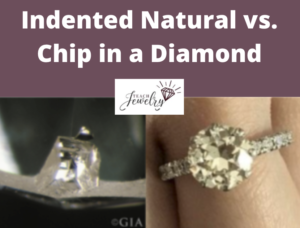
Indented naturals and chips in a diamond affect its durability, brilliance, and appearance. They aren’t as common as other inclusions, but it’s important to know how they impact a diamond’s value.
The main difference between indented naturals and chips is indented naturals are an inclusion resulting from the rough diamond receding below the surface. Chips are a break in its structure that are often caused by a weak point experiencing hard impact.
Let’s compare indented naturals versus chips, including an overview of each, how they’re different, similarities, and if you should consider diamonds with either flaw.
What is an Indented Natural?
An indented natural is an inclusion that’s part of the original rough diamond’s surface. It recesses below the surface of the polished diamond to create a dip.
Indented naturals are often found near the girdle. They allow you to see what the diamond looked like before undergoing the manufacturing and cutting process.
While most inclusions are a blemish that developed during its formation, indented naturals are a part that wasn’t polished away.
They come in multiple sizes. A small indented natural may only show under 10x magnification, while a larger one could be visible to the naked eye. The extent of its impact on the diamond’s brilliance and durability is dependent on its size and location.
This information is found in the clarity characteristics plot of a report from the GIA, AGS, or another organization that evaluated the diamond.
Here’s an example of one from the GIA, and I’ve highlighted instances of indented naturals.
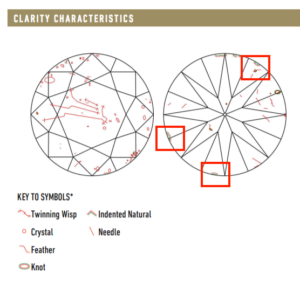
A small occurrence won’t often diminish its brilliance or durability, but a large one could cause that area of the diamond to be more vulnerable to breaking.
For example, the below diamond has a small indented natural that won’t affect its quality to a significant degree.
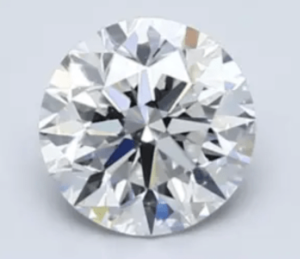
It’s less impactful than other inclusions such as sizable feathers or cavities.
What is a Chip in a Diamond?
A chip in a diamond is a shallow opening on its surface.
In some areas, cleavage lines feature atoms that aren’t tightly bonded together. This creates a weak point in its structure that can break if struck against a hard surface.
In the image below, notice the fissures on its pavilion and how easily they could break open.
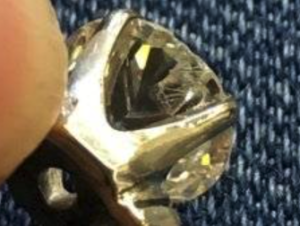
Chips are often man-made inclusions.
If the diamond isn’t protected by the setting, or it has an extremely thin girdle, it’s more likely to crack if dropped. For example, prong settings grasp the diamond by its edges, leaving more of it exposed and vulnerable to chipping.
Bezel settings, on the other hand, wrap all the way around the diamond and secure its edges.
It hides more of the diamond, which is one of its disadvantages, but there’s added protection.
A diamond is more likely to chip if inclusions are found near the girdle.
The combination of a thin girdle and other imperfections means the diamond is susceptible to breaking. Feathers and cavities already diminish the structural integrity of the stone, and ones located near a thin point on the diamond may lead to a chip.
That’s why I recommended examining the clarity characteristics plot to learn their location. To illustrate, princess cuts have sharp corners that are more vulnerable than rounded edges.
But the inclusions in this SI2 clarity princess cut are located toward the center.
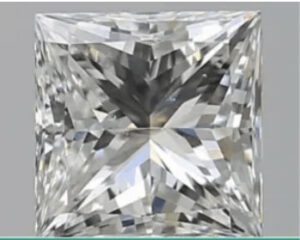
Although I don’t recommend selecting this low of a clarity grade, I have confidence it’s not prone to chipping.
How are Indented Naturals and Chips Different?
1. Chips Create Risk of Further Damage
A diamond with a chip is more vulnerable to further damage than one with an indented natural.
Dropping the stone or hitting it against a hard surface weakens its structure. When one piece comes off, it leaves the rest of it more susceptible to the same result.
The same isn’t true of indented naturals. The inclusion isn’t a piece of the polished diamond breaking off. Instead, it’s the rough diamond that wasn’t removed.
Even though it’s an imperfection, it’s not one that poses further risk for the diamond in most situations. There’s just part of the diamond that dips below the surface.
2. Indented Naturals Aren’t a Break in the Diamond
Indented natural inclusions aren’t part of the diamond breaking off. It’s the original diamond recessing into the stone, creating a small bump.
A chipped diamond is when part of the final cut has been removed. It creates an opening that exposes the stone to more damage.
Dirt and grime can also fill the hole, which affects its appearance.
Even if your diamond is otherwise eye-clean, the debris that sits in the chip can leave marks visible to the naked eye.
3. Chips Significantly Decrease the Value of a Diamond
All inclusions decrease the value of a diamond, but this is especially true of chips versus indented naturals.
You can learn the impact of inclusions on price by comparing two diamonds that have all other traits in common except for their clarity grade.
You’ll see a 5-15 percent drop in the average price of a diamond for every grade lower on the clarity scale, such as from a VVS1 to a VVS2 or an S1 to an S2.
This is the type of price decrease to expect from minor inclusions such as indented naturals, but the difference is more pronounced with chips.
It’s easy to see why someone would pay far less for a diamond with a crack it in like the one below.
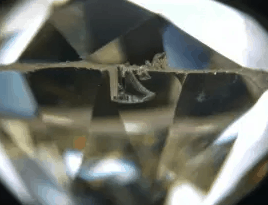
One way of determining the price of a chipped diamond is to downgrade its clarity to I3, which is the lowest it can receive.
Compared to a diamond with moderate clarity, such as a VS2, it could be discounted up to 75 percent.
So a VS2 diamond that used to cost $4,000 may only be worth $1,000 if it’s chipped.
The other method of determining its value is learning what its carat weight would equal if the chip were removed through recutting the diamond.
It often requires removing a significant portion of the diamond to make it appear like new again, so the drop in carat weight lowers the price.
4. Chips are Removed Through Recutting
A common question regarding inclusions is whether they can be removed. They decrease the value of a diamond, so it’s natural to wonder if removing them will increase its value.
Chips can be removed through recutting the diamond.
Depending on the size and location of the chip, it often requires cutting away much of the diamond’s carat weight.
Carat weight has a direct impact on the diamond’s value, so removing the chip is a cost-benefit analysis of whether the lost carat weight is worth a diamond free of chips.
To provide a real example, here’s two round-cuts that have the same grades except for a difference of 0.1 in carat weight.
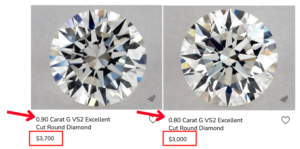
The price difference is $700, which demonstrates the lost value in removing a chip and reducing carat weight.
Indented naturals aren’t often removed from a diamond. It would also result in shedding carat weight, and because the inclusion has a minimal impact on the diamond, it’s not worth it.
Are There Any Similarities Between Them?
Although indented naturals and chips affect a diamond in different ways, the inclusions do have similarities.
First, they’re man-man inclusions. Many others form in a diamond well before they’re cut and sold, but diamonds often aren’t sourced with these flaws.
Between the numerous steps involved between sourcing and selling a diamond, it’s not uncommon to see diamonds have an indented natural or chip.
Additionally, they’re both often found near the girdle. It’s where the rough diamond isn’t polished as much during the manufacturing process and where the stone is likely to have weak points.
These factors leave the girdle vulnerable to both.
Should You Consider a Diamond with an Indented Natural or Chip?
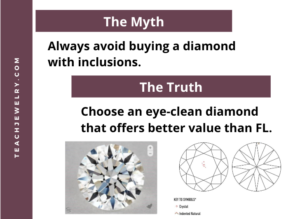
Avoid buying a diamond with a chip, but small indented naturals shouldn’t eliminate a diamond from consideration.
A chip poses multiple issues. It creates risk for further damage because the stone is weakened. It minimizes brilliance because light cannot properly enter and exit the diamond. The value plummets.
Indented naturals, like any other inclusion, lowers the clarity grade but shouldn’t be a dealbreaker.
Nearly every diamond sold has some degree of inclusions. It’s about choosing which ones have the least impact on quality because it’ll save you money compared to a flawless one.
Always view a diamond in-person or through high-resolution photos online before purchasing, and examine the grading report to learn the size and location of inclusions.
Pass on any diamond with chips, but ones with indented naturals can still be the right pick for you.

Jacob Clarke
Jacob Clarke is the founder of TeachJewelry.com.
He earned an Applied Jewelry Professional Diploma from the Gemological Institute of America (GIA) and now brings you essential information about diamonds, settings, and more.
Jacob has consulted with leading jewelry brands, and his work has been cited in Clean Origin, Diamond Nexus and industry publications.
He's also a member of the International Gem Society.
He enjoys discussing jewelry with readers, so contact him with any questions at jacob.clarke@teachjewelry.com.













